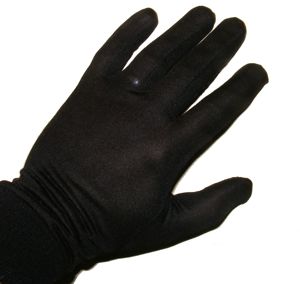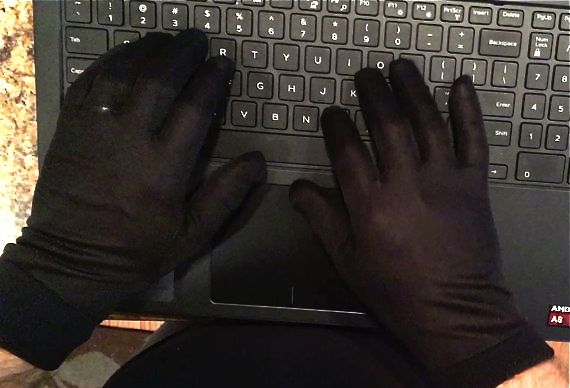by Benjamin Sobieck
The pursuit of wellness during the act of writing can
take some unusual twists and turns.
Case in point: what began as having cold hands while I typed at the keyboard ended as an unexpected opportunity for my writing career.
Cold Hands Can Equal Missed Deadlines
Cold, stiff hands during the winter months is nothing new for writers, as Writing and Wellness has covered before, but it was new to me a couple years ago. I was writing a book for Writer’s Digest, and I wanted to make an impression. But we’re talking about Minnesota. These aren’t typical winters. It gets capital-C Cold out.
In a home office with two windows and a bit of a draft where I would sit still for long stretches of time, that meant my productivity slowed as my hands grew colder. This put my deadlines in jeopardy. I needed every minute and every word I could get.
The standard remedies on the Internet bordered on the condescending. “Get up and walk around to get the blood flowing.” “Install a portable heater.” “Rub your hands together.” “Drink something hot.”
Gee, growing up in Minnesota, I never thought of those things before. Thanks, Internet!
Walking around isn’t compatible with “the zone” that’s so precious and rare to writing. Interruptions are out of the question. Portable heaters are okay, but my hands and fingers specifically needed warming, not the entire room. I actually prefer it to be cooler than warmer.
I’ll summarize my reply to rubbing my hands together and drinking hot liquids as “you don’t get it.”
I checked out fingerless typing gloves as one possible solution. They work for some people, but not me. I wanted something with coverage for the fingers. Full-sized, regular gloves are too bulky, and I can’t “feel” the keys.
It’s Not Only Books that Writers Can Sell
Am I a chronic complainer? Heck no. I’m a writer. I got creative. I leveraged that curiosity inherent to writing and started digging for a better way, even if that meant creating it from scratch.
The result was a form-fitting typing glove that’s warm, breathable and fits like a second skin over my entire hand. I could jockey keys all day and forget I was wearing it.
I customized the gloves further with touchscreen capability in the index fingers so I wouldn’t have to remove them to work my smartphone. The material the gloves are made from is slippery, so I added a custom grip.
It turned out to be worth the effort. My writing project hit the editors ahead of deadline despite the cold temps. I found myself between projects, mulling over which one to take on next. Then something hit me. Those gloves on my desk next to the keyboard, they could help other people, too, and not just writers. What if I sold them myself?

Your Wellness Solution for Writing Could Also Be Your Next Opportunity
Pairing hard goods with books makes business sense for the agile “authorpreneur.”
Pierce Brown, author of the Red Rising series, for example, produces knives related to his stories, of all things. He’s more established than I am, but this approach doesn’t have to be out of reach for the average writer still building a platform.
Product creation is another way of telling a story, whether it’s about yourself or your fictional worlds.
For me, getting cold hands while typing at the keyboard turned into what’s now called The Writer’s Glove, and it changed the trajectory of my writing career. I learned more about writing books, and how to sell them, by creating a non-book product than anything my creative writing minor could’ve taught me.
That’s not a dig at my education, but it is a testimony to thinking outside the boxes of book covers.
The Antidote to Hoping Readers Will Find You: Target a Customer Group
Too often, writers create works with the hopes that the “right readers” will find them. I know this because I’ve done it myself. If the prose is perfect, the descriptions are darling, the plot is on point and readers can care about the characters, the rest will fall into place. If the readers aren’t tripping over themselves to buy books, just write a better story. Or so they say.
What developing The Writer’s Glove taught me is that that’s another way of saying, “I hope I get lucky.” In a world where hundreds of thousands of new titles go live every year, you’re better off with a lottery ticket.
The antidote is to target a customer group. Don’t go after the whole pie. Go for a slice of it.
That’s exactly what I did with The Writer’s Glove. I created a profile of the kind of person who would buy these gloves. It was easier said than done, but I imagined myself rounding up 100 perfect customers. Each of them, in my mind, had a handful of attributes in common.
With those down, I went to the best friend anyone in Internet marketing could have: Google Adwords. It’s free to use and only requires a Gmail e-mail account (also free) to access. Its powerful keyword-planning tool allows anyone to search for traffic volumes of certain phrases people use in Google.
All I needed to do was match up my perfect customer attributes with keywords.
Not only did I now know who my perfect customer would be, I knew how they would use Google to find my product. I loaded descriptions, blog posts and other online elements with those keywords to help Google make the connection.
Doesn’t that sound better than relying on luck?
Keep Your Ideal Reader in Mind for Better Self-Publishing Success
After quickly seeing results, I took the same approach to my self-published writing projects, the ones I could exercise the most control over. With the ideal reader in mind and the right keywords juicing my work’s descriptions and landing pages, I’m no longer spinning my wheels trying to find readers. They come to me.
It’s not like this is some secret formula. I don’t view the writing market as a zero sum game anyway. But I do think this is another reason to take your wellness issues seriously as both a writer and an entrepreneur. Your solutions could turn into opportunities to make some extra money, help other people, and improve your writing career overall.
* * *
 Benjamin Sobieck is the author of The Writer’s Guide to Weapons: A Practical Reference for Using Firearms and Knives in Fiction (Writer’s Digest Books) and several thrillers, including Glass Eye: Confessions of a Fake Psychic Detective and the Chase Baker series with Vincent Zandri.
Benjamin Sobieck is the author of The Writer’s Guide to Weapons: A Practical Reference for Using Firearms and Knives in Fiction (Writer’s Digest Books) and several thrillers, including Glass Eye: Confessions of a Fake Psychic Detective and the Chase Baker series with Vincent Zandri.
In his professional career, he works as a director of digital business strategy for F+W. It’s a content and e-commerce company that publishes magazines, books, television shows and digital content. Brands he’s worked for include Gun Digest, BLADE, Modern Shooter, Living Ready, Deer & Deer Hunting, Tactical Gear and many others. Prior to that, he worked as a government and crime reporter for a few newspapers.
For more about The Writer’s Glove, go to TheWritersGlove.com.
Ben also blogs about weapons in fiction at CrimeFictionBook.com. Connect with him on Twitter and Pinterest.



I’d like to order some, but cannot find anything on sizes. I typically buy women’s large gloves; should I get medium or large in these?
Hi Kat,
Thanks for your question. You’d be best with a large. The sizes translate over well from other typical glove sizes. I hope that helps!
Thank you,
Ben
Love the pic at the top. Thanks again for running this!
Ha ha. Thank you, Ben!